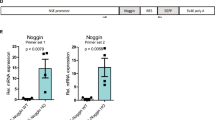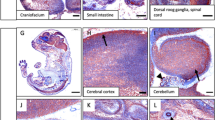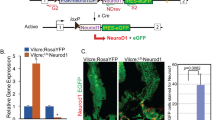Abstract
The isolated homeobox gene Enx (Hox11L1) is expressed in enteric neurons innervating distal ileum, and proximal and distal colon. Enx-deficient mice develop megacolon with massive distension of the proximal colon. The number of myenteric ganglia, total neurons per ganglion, and NADPH diaphorase presumptive inhibitory neurons per ganglion are increased in the proximal and distal colon, but decreased in the distal ileum of all Enx−/− mice. Enx−/− mice provide a model for human neuronal intestinal dysplasia (NID), in which myenteric neuronal hyperplasia and megacolon are seen. These results suggest that Enx is required for the proper positional specification and differentiate cell fate of enteric neurons.
This is a preview of subscription content, access via your institution
Access options
Subscribe to this journal
Receive 12 print issues and online access
$209.00 per year
only $17.42 per issue
Buy this article
- Purchase on Springer Link
- Instant access to full article PDF
Prices may be subject to local taxes which are calculated during checkout
Similar content being viewed by others
References
Krumlauf, R. Hox genes in vertebrate development. Cell 78, 191–201 (1994).
Hatano, M., Roberts, C.W.M., Minden, M., Crist, W.M., Korsmeyer, S.J. Deregulation of a homeobox gene Hox11, by the t(10;14) in T cell leukemia. Science 253, 79–82 (1991).
Kennedy, M.A. et al. Hox11, a homeobox-containing T-cell oncogene on human chromosome 10q24. Proc. Natl. Acad. Sci. USA 88, 8900–8904 (1991).
Roberts, C.W.M., Shutter, J.R. & Korsmeyer, S.J. Hox11controls the genesis of the spleen. Nature 368, 747–749 (1994).
Dear, T.N. et al. The Hox11 gene is essential for cell survival during spleen development. Development 121, 2909–2915 (1995).
Roberts, C.W.M., Sonder, A.M., Lumsden, A. & Korsmeyer, S.J. Developmental expression of Hox11 and specification of splenic cell fate. Am. J. Pathol. 146, 1089–1101 (1995).
Dear, T.N., Sanchez-Garcia, I. & Rabbitts, T.H. The HOX11 gene encodes a DNA-binding nuclear transcription factor belonging to a distinct family of homeobox genes. Proc. Natl. Acad. Sci. USA 90, 4431–4435 (1993).
Rothman, TP. & Gershon, M.D. Phenotypic expression in the developing murine enteric nervous system. J. Neurosci. 2, 381–393 (1982).
Heinicke, E.A., Kiernan, J.A. & Wijsman, J. Specific, selective, and complete staining of neurons of the myenteric plexus, using cuprolinic blue. J. Neurosci. Methods 21, 45–54 (1987).
Gabella, G. Size of neurons and glial cells in the intramural ganglia of the hypertrophic intestine of the guinea-pig. J. Neurocytol. 13, 73–84 (1984).
Schuchardt, A., D'Agati, V., Larsson-Blomberg, L., Constantini, F. & Pachnis, V. Defects in the kidney and enteric nervous system of mice lacking the tyrosine kinase receptor Ret. Nature 367, 380–383 (1994).
Edery, P., et al. Long segment and short segment familial Hirschsprung's disease: Variable clinical expression at the RET locus. J. Med. Genet. 31, 602–606 (1994).
Sanchez, M.P. et al. Renal agenesis and the absence of enteric neurons in mice lacking GDNF. Nature 382, 70–73 (1996).
Pichel, J.G. et al. Defects in enteric innervation and kidney development in mice lacking GDNF. Nature 382, 73–76 (1996).
Moore, M.W. et al. Renal and neuronal abnormalities in mice lacking GDNF. Nature 382, 76–79 (1996).
Hosoda, K. et al. Targeted and natural (piebaldlethal) mutations of endothelin-B receptor gene produce megacolon associated with spotted coat color in mice. Cell 79, 1267–1276 (1994).
Baynash, A.G. et al. Interaction of endothelin-3 with endothelin-B receptor is essential for development of epidermal melanocytes and enteric neurons. Cell 79, 1277–1285 (1994).
Schärli, A.F. & Meier-Ruge, W. Localized and disseminated forms of neuronal intestinal dysplasia mimicking Hirschsprung's disease. J. Pediatr. Surg. 16, 164–170 (1981).
Reifferscheid, P. & Flach, A. Particular forms of Hirschsprung's disease. in Hirschsprung's Disease. (ed. Holschneider, A.) 133–151 (Stratton, New York, 1982).
Hofstra, R.M. et al. A mutation in the RET proto-oncogene associated with multiple endocrine neoplasia type 2B and sporadic medullary thyroid carcinoma. Nature 367, 375–376 (1994).
Barone, V. et al. Exclusion of linkage between RET and neuronal intestinal dysplasia type B. Am. J. Med. Genet. 62, 195–198 (1996).
Munakata, K., Morita, K., Okabe, I. & Sueoka, H. Clinical and histologic studies of neuronal intestinal dysplasia. J. Pediatr. Surg. 20, 231–235 (1985).
Young, H.M., Furness, J.B., Shuttlworth, C.W.R., Bredt, D.S. & Snyder, S.H. Co-localization of nitric oxide synthase immunoreactivity and NADPH diaphorase staining in neurons of the guinea-pig intestine. Histochemistry 97, 375–378 (1992).
Dawson, T.M., Bredt, D.S., Fotuhi, M., Hwang, P.M. & Snyder, S.H. Nitric oxide synthase and neuronal NADPH diaphorase are identical in brain and peripheral tissues. Proc. Natl. Acad. Sci. USA 88, 7797–7801 (1991).
Yunker, A.M. & Galligan, J.J. Endogenous NO inhibits NANC but not cholinergic neurotransmission to circular muscle of guinea pig ileum. Am. J. Physiol. 271, pp (1997).
Wolgemuth, D.J., Behringer, R.R., Mostoller, M.P., Brinster, R.L. & Palmiter, R.D. Transgenic mice overexpressing the mouse homeobox-containing gene Hox-1.4 exhibit abnormal gut development. Nature 337, 464–467 (1989).
Tennyson, V.M. et al. Structural abnormalities associated with congenital megacolon in transgenic mice that overexpress the Hoxa-4 gene. Dev. Dyn. 198, 28–53 (1993).
Gershon, M.D., Chalazontis, A. & Rothman, T.P. From neural crest to bowel: Development of the enteric nervous system. J. Neurosci. 24, 199–214 (1993).
Hug, B. et al. Analysis of mice containing a targeted deletion of beta-globin locus control region 5′ hypersensitive site 3. Mol. Cell. Biol. 16, 2906–2912 (1996).
Huang, S. et al. Immune response in mice that lack the interferon-γ receptor. Science 259, 1742–1745 (1993).
Author information
Authors and Affiliations
Rights and permissions
About this article
Cite this article
Shirasawa, S., Yunker, A., Roth, K. et al. Enx (Hox11L1)-deficient mice develop myenteric neuronal hyperplasia and megacolon. Nat Med 3, 646–650 (1997). https://doi.org/10.1038/nm0697-646
Received:
Accepted:
Issue Date:
DOI: https://doi.org/10.1038/nm0697-646
This article is cited by
-
Comprehensive analysis of TLX2 in pan cancer as a prognostic and immunologic biomarker and validation in ovarian cancer
Scientific Reports (2023)
-
A novel mouse model of intestinal neuronal dysplasia: visualization of the enteric nervous system
Pediatric Surgery International (2023)
-
Letter to the Editor
Pediatric Surgery International (2023)
-
Genetic background-dependent abnormalities of the enteric nervous system and intestinal function in Kif26a-deficient mice
Scientific Reports (2021)



